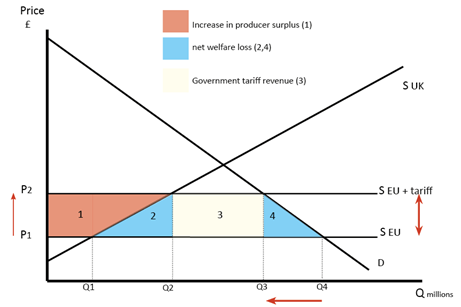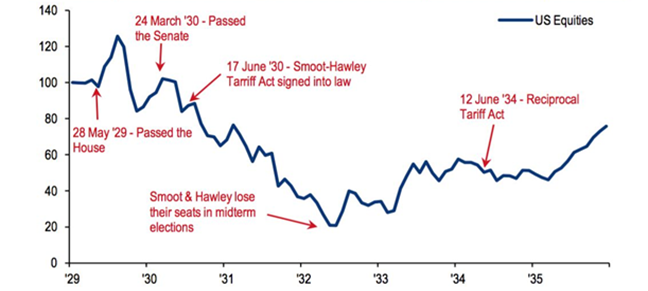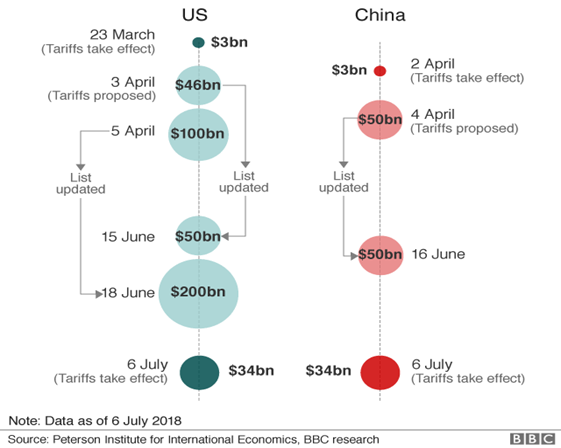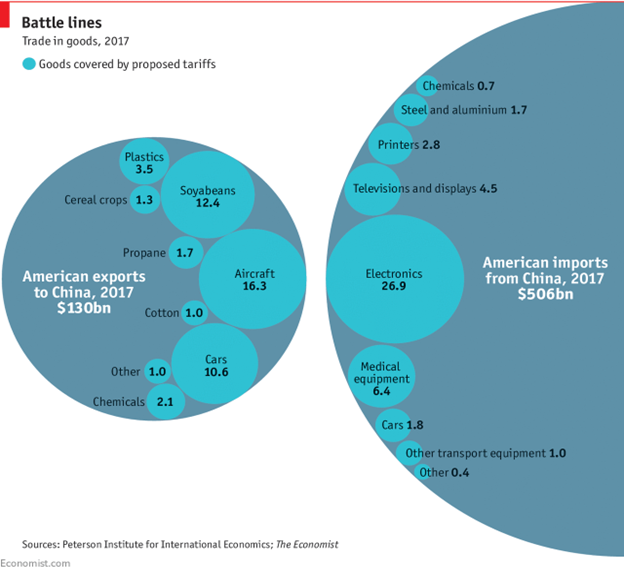Blog by: Shashwat Gupta, Himani Sheth, Venkat Samala, Onkar Habbu
Trade plays an important role in the growth of the world economy. This is evident from Figure 1 which shows that global trade in goods and services grew at an average real rate of 6% a year from the 1960s to the 2007 global financial crisis, twice as much compared to the 3% annual real GDP growth during the same period.

Figure 1. Real Trade and Real GDP, 1960 – 2016
However, with a slowdown in the pace of trade reforms and the rise of protectionism, the role of trade is at a critical juncture. In such a scenario, one of the conflicts which can severely impact the world economy is a trade war.
So what exactly is a trade war?
Trade war, as the name suggests is an economic war between nations. It results from countries’ extreme protectionist stance wherein countries impose tariff and quota restrictions and other trade barriers to damage each other’s trade; thereby offsetting their imports.
But who does it help then?
A trade war may commence if one country perceives another country’s trading practices to be unfair. Protectionist measures are used to protect domestic industries and to increase employment. Increasing the tariff on other countries’ goods and services reduces their competitiveness which gives a boost to domestic production. Domestic trade unions and lobbyists also pressure politicians to make imported goods less attractive to consumers. In addition to raising revenue for the government, it also helps in guarding new or key industries against free trade. A reduction in the quantity of and total spending on imports may also improve a nation’s trade balance. However, one of the repercussions of these measures can be the action taken by another country. It can retaliate against tariffs using tit for tat strategy and in such scenario, benefits from tariffs are more difficult to be estimated.
These benefits from protectionism are contrasted with its costs. Tariffs result in inefficient resource allocation in long run. The producers which are protected do not face international competition and don’t have the incentive to innovate and reduce costs. Domestic products lose their competitive advantage in the world market and exports of the country suffer in long run. Tariffs also increase prices in the domestic market and have an adverse impact on consumers. Distortion in price signals may result in directing investment in inefficient industries.
And the economics behind it.
Economically, tariffs result in an overall welfare loss for the country. Considering Demand and supply curve as given in Fig 2, losses and gains from imposing a tariff on imports can be identified.

Figure 2. Pictorial view understanding net welfare loss
Losses:
- Domestic consumers have to pay higher prices (P2 compared to P1). This also results in a reduction of demand from Q4 to Q3 This results in lost consumer surplus of the indicated area (1+2+3+4)
- Foreign Exporting firms’ exports reduce from (Q4 – Q1) to (Q3 – Q2).
- Demand for other firms in the economy reduces. This is because consumers have less real purchasing power as prices increase due to tariffs.
Gains:
- The government collects revenue of area 3
- Domestic Producers who are able to sell higher quantity (Q2 instead of Q1) at a higher price. Producer surplus increases by area 1
From the above losses and gains, it can be identified that the loss in the country’s welfare is due to the imposition of a tariff is the indicated area (2+4).
In addition, protectionist measures tend to be met with some forms of retaliation. Protection against imports is accompanied by a fall in exports for the country. These measures also have a downward multiplier effect for the world economy. When a country protects itself against imports, exports of other nations fall which affects their aggregate demand. Fall in aggregate demand and national output results in the reduction of their imports as imports are a function of national income. This process when continues results in a downward spiral of reduced trade and world output.
Is it something new?
Trade has been the reason for the rise and fall of empires, civilisations and countries since ages. Trade blockade was used as a weapon by Napoleon to paralyse Great Britain through the destruction of British commerce in Napoleonic wars. The system hurt English industries but also damaged regions of France dependent on overseas commerce. The need for trade resulted in evasions of blockade as well as large-scale smuggling, and French allies themselves ignored the trade blockade. Regulation of trade in colonies, navigation acts and mercantilist policy of Britain sowed the seeds of the American revolution. In India too, the East India company used tariff structure to promote import of raw material from India and export finished goods from Britain to India.
The most glaring example of how protectionist policies can lead to a significant downturn in the global economy comes from Great Depression years of the 1930s. As the global economy entered the first stages of the Great Depression in 1929, the tariff act of 1930, also known as Smoot-Hawley Tariff implemented protectionist trade policies to protect American jobs and farmers from foreign competition. Threats of retaliation by other countries were swift and foreign governments increased rates against American products. The result was more prolonged and exacerbated Great Depression. Figure 3 shows the adverse impact of the act on US securities.

Figure 3. Impact of 1930 Smoot-Hawley Tariff Act on US equities
The present:
With all the recent hostilities, it’s easy to forget that China and the United States have been top trading partners for years.
In 2015, China overtook Canada as the United States’ largest trading partner, boasting nearly $500 billion in total imports and exports, about 15 per cent of total U.S. trade. The United States, on the other hand, has been China’s top trading partner since the 1990s, overtaking Hong Kong as the largest importer of Chinese merchandise goods in 1998.


Figure 4. China US trade relationship
In early 2018, the US under the presidency of Donald Trump introduced the first set of tariffs on the import of solar panels and washing machines. The decision was not well received by China since it accounted for the major part of those import. Within months of threatening to do so, US raised the import taxes on steel and aluminium, majorly importing from EU and China, exempting its NAFTA partners among few others.
Donald Trump, under his campaign promise of ‘America First’, has been very clear of his discomfort with the increasing US trade deficit, with China holding the lion’s share of it. He had vowed to cancel many international trade deals, targeting China for its ‘unfair trade practices over the years’. Trump justified the tariffs on the grounds of protecting homegrown industries and generating jobs for the Americans.
These tariffs were not just limited to China and the EU, but could likely affect with India, South Korea and other nations, a move slowly secluding the US into its cocoon.
The retaliation
As expected with the escalating tariffs, China wouldn’t just be sitting ducks. When Washington imposed the first round of 25 per cent tariffs on $34 billion of Chinese goods, China quickly issued tariffs on an equivalent billion dollars in US exports, disproportionately affecting US farmers. Even the EU retaliated with tariffs on almost $3.2 billion worth of US imports, including whiskey, tobacco and Harley Davidson, just to give a strong message to Trump. This round of tariff was surrounded by waves of tit-for-tat trade attack proposals, targeting China’s ‘Made in China 2025’ plan, to US agricultural industry, to just knee-jerk reactions. An updated timeline of the battle is in the figure below

Figure 5. How the tariff battle escalated this year
Impact on countries
Does it make America great again?
As can be seen from the below infographic, the first impression comes of the strong stance of US in this trade war. But the impact is not all so rosy. US farmers can be significantly affected because of the retaliatory measures put extensively on agricultural and dairy produce. So can the aircraft and automobile industry due to adverse effects of exports of these sectors to other nations. While the domestic industry might thrive under protectionism, consumers of the goods could face higher prices with a lesser choice. Some companies have also moved their production out of US to have a better international export market. All of these might hurt the employment rate, prices and consumers at the very end.

Figure 6. Goods covered by proposed tariffs
How is China holding up?
With proposed tariffs on Chinese exports to the US worth more than $500 billion, it is going to pinch many vital Chinese industries.
The impact of the Washington-Beijing trade skirmish will be relatively muted on the Chinese economy, noting that exports to the U.S. do not hold a commanding presence in China’s economic portfolio. But having said that, the trade war with the U.S. couldn’t have come at a worse timing for China, which had just begun focusing “in earnest” on fixing problems with its economy.
China’s banks had extended a record 12.65 trillion yuan ($1.88 trillion) in loans in 2016 as the government encouraged credit-fueled stimulus to meet its economic growth target. The credit explosion stoked worries about financial risks from a rapid build-up in debt, which authorities in 2017 pledged to contain. Both China’s monetary and fiscal policies have been kept on a tight leash so far this year and deleveraging — the process of reducing debt — has been hastened through tighter regulations. After years of hand-wringing and navel-gazing, China had finally begun to focus in earnest on curbing credit growth, until this moment of the ongoing trade war.
Analysts have suggested that under the circumstances, easing monetary conditions to support demand and allowing the currency to absorb the shock of the trade war are the right policy choices. The depreciation of the yuan would offset the loss in export competitiveness for Chinese exporters due to higher tariffs, meaning that Chinese goods will essentially be cheaper to Americans.
But this comes as a juxtaposition – Beijing is seeking to implement a relatively tight monetary policy to force financial deleveraging, but it also needs easier monetary conditions to support growth.
Given the limits of using monetary policy, fiscal measures to support exporters or boost domestic demand could also be used. That could include increasing tax rebates — known as the value-added tax credit rate — to exporters in China which would raise their income by between 3.5 per cent and 4 per cent.
Is it impacting India?
When a trade war happens, it just doesn’t affect the two economies involved but all the economies open to world trade. It comes as no surprise here that India is getting dragged into this. The basic principles of economics, i.e., demand and supply, will once again come into play. The shortage of supply of a good, either finished material or raw material, will increase the final consumption price for the consumer. Moreover, the burden of increased tax from the duties will also be borne by the final user.
Impact on rupee – Since August 2018, the value of rupee has been continuously falling to new lows against the dollar, which coincided with Trump’s threat of imposing a new round of tariffs on exports worth $200 billion. This is one of out of the slew of reasons that led to USD appreciation; the burden on India’s trade deficit is steadily increasing owing to the manifold impact of depreciating rupee and rising oil prices in rupees.
Impact on the stock market – With a cautious approach of the investors, the key indices in the Indian share market took a dip amid global concerns with the threat announcements, but they have since then regained their bullish growth.
Impact on trade deficit with the US – As the United States of America imposed duties on steel and aluminium, India now has to pay approximately $241 million worth of tax to the US. India, on the other hand, as a countermeasure has proposed imposing duties on 30 different types of goods. This will ensure that the US has to pay about $238 million as duties to India. However, this will make life more difficult for the end consumers as everything that falls under the tariff scanner is expected to become more expensive.
Impact on industries: The additional duty imposed could have a detrimental effect on the manufacturing industry, as the cost of production will go up due to the rise in the price of raw materials. Moreover, other things which may face an increase in price include foreign motorbikes with high engine capacity and food products like almonds, walnuts, pulses, etc.
US embargo on Iran: On May 8, US government decided to pull out of Iran Nuclear deal and threatened to impose economic sanctions on countries that continue to trade with Iran. Given that Iran was the fourth largest oil exporter (12% of the country’s imports in 2017-18) to India, the following factors may adversely affect India:
- Iran offers crude oil at better terms (Longer credit period, freight discount) to India. Negotiating new terms with other countries could make crude costlier for India.
- As the sanctions kick in, the oil production from Iran will dry up, leading to lower crude oil output, which could eventually push the crude prices up if OPEC members do not increase their production to the extent of the shortfall.
- Iran accepts part payment for the oil purchases in rupees (other import partners are paid in USD). This, in turn, helps in reducing the USD demand and keeping INR stronger.
Key indicators to assess the impact of the trade war:
There are few economists who are dismissive about these retaliations by claiming the US-China threats are more bark than bite. Keeping a check on the following indicators could be a good way to assess the damage done by the trade war:
- IFO – Germany as the largest European economy and one of the largest exporters, would be particularly exposed to any trade slowdown. The Germany-based IFO Economic Research Institute produces leading confidence indicators for the Euro area and Germany.
- South Korea and Taiwan Export numbers:
As one of the largest intermediate goods exporters for goods manufactured in China and the US, the impact of a trade war would definitely be first visible in the export figures of these countries.
- New export orders:
New export component from the JP Morgan Global Manufacturing purchasing managers index could give a fuller picture of the demand visibility.
- Purchasing Managers’ Index (PMI) of Asia and Europe:
The trade war threats have a negative bearing on the manufacturers’ sentiment as reflected by the PMI.
- China trade data:
Economists often cite China’s trade data to be representative of global demand. An index following China’s export orders/trade volume could help in deciphering the impact of the trade war.
The global economy and deglobalisation?
After World War II, America has written and dominated the rules of global business and international relations. Many of the major world organisations, like the UN, WTO, World Bank, IMF, G7, NATO as well as regional ones – the EU and NAFTA, were functioning under American dominance and majorly for her interest.
Under the Trump era, the US Establishment launched the process of “deglobalization.” Under the slogan “America First,” the president has withdrawn support from the Paris climate accord, the TPP, the Iran nuclear deal and UNESCO. It threatens to leave the UN and even NATO. Washington has violated multilateral agreements and international treaties and has tried to impose new rules on its partners. Dissatisfied with the American domination in world trade, the nations have started to come together to coordinate their views and activities, with the beginning of the 21st century seeing several new regional and international organisations being formed.
The way forward:
Regional trade agreements provide more favourable market access conditions to signatories and thus facilitate trade by reducing barriers across parties. Partners agreeing on common standards and deriving benefits from mutually enhanced trade can form trade agreement among them. This is in contrast with WTO procedure which works on the principle of consensus and requires the approval of all members.
It has been emphasised by WTO members that Regional Trade Agreements must remain complementary to, and not a substitute for a multilateral trading system. WTO Director-General Roberto Azevedo has said that “many key issues – such as trade facilitation, services liberalisation, and farming and fisheries subsidies- can only be tackled broadly and efficiently when everyone has a seat at negotiating table.” Multilateral trade agreements also provide an opportunity to all nations keep their views over trade matters and policies which helps in integration of developing and least developed countries in the world economy. This is essential because of the today’s interconnected world where actions of one nation affect not only the involved parties but other nations as well.
Beggar-thy-neighbour policies which entail the use of increased tariffs, import quotas and restrictions only propagate trade wars. These are detrimental not only to participating nations but to the whole world economy due to reduced demand and investor confidence. Multiple regional trade agreements, WTO, IMF and other measures to ensure free and fair trade play their part to reduce the probability of trade wars and their impact should they ensue. Cooperation of all nations in multilateral platforms such as WTO is necessary to make the best use of gains from trade and share the benefits across all parties.
Disclaimer – All the views expressed are opinions of Networth – IIMB Finance Club – members. Networth declines any responsibility for eventual losses you may incur implementing all or part of the ideas contained in this website.
Sources:
https://www.bbc.com/news/world-43512098
